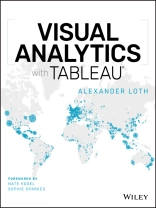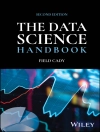A four-color journey through a complete Tableau visualization
Tableau is a popular data visualization tool that’s easy for individual desktop use as well as enterprise. Used by financial analysts, marketers, statisticians, business and sales leadership, and many other job roles to present data visually for easy understanding, it’s no surprise that Tableau is an essential tool in our data-driven economy.
Visual Analytics with Tableau is a complete journey in Tableau visualization for a non-technical business user. You can start from zero, connect your first data, and get right into creating and publishing awesome visualizations and insightful dashboards.
• Learn the different types of charts you can create
• Use aggregation, calculated fields, and parameters
• Create insightful maps
• Share interactive dashboards
Geared toward beginners looking to get their feet wet with Tableau, this book makes it easy and approachable to get started right away.
表中的内容
About the Author vii
About the Technical Editors ix
Credits xi
Acknowledgments xiii
Foreword by Nate Vogel xxi
Foreword by Sophie Sparkes xxiii
Introduction xxv
Chapter 1: Introduction and Getting Started with Tableau 1
The Advantages of a Modern Analytics Platform 2
My Personal Tableau Story 3
The Tableau Application Suite 4
Installing Tableau Desktop 5
System Requirements for Tableau Desktop 5
Downloading and Installing Tableau Desktop 6
Registering and Activating Tableau Desktop 6
Data Preparation 6
Crosstab Reports with Wide Tables 7
Preparing Your Data for Analysis 8
Long Tables Suitable for Analysis 8
The Sample Dataset 9
Finding the Dataset 9
Understanding the Data 10
Opening the Excel File Containing the Sample Dataset 11
The Tableau Workspace 13
The Menu Bar 15
The Data Pane 16
Working with Measures and Dimensions 17
Visualizing a First Measure 17
Breaking Down a Measure Based on a Dimension 17
Working with Marks 19
Working with Color 20
Adding More Information to Tooltips 21
Saving, Opening, and Sharing Your Workbooks 21
Saving Workbooks 21
Opening Workbooks 23
Sharing Workbooks with Tableau Reader 23
Chapter 2: Adding Data Sources in Tableau 25
Setting Up a Data Connector 26
Connecting to a File 27
Connecting to a Server 28
Connecting to a Cloud Service 30
Selecting Data Tables 31
Adding a Table to a Data Model 31
Joins 31
Unions 34
Specific Unions (Manual) 34
Wildcard Unions (Automatic) 35
Data Extracts and Live Connections 36
Live Connections 36
Untethered with a Data Extract 37
Data Protection and Data Governance 38
Editing the Model’s Metadata 38
Data Types 40
Changing a Field’s Data Type 41
Adding Hierarchies, Calculated Fields, and Table Calculations 41
Data Collection 42
Data Collection with IFTTT and Google Sheets 42
Website Analysis with Google Analytics 43
Checklist for Increasing Performance 46
General Advice for Performance Optimization 46
Performance Optimization with Files and Cloud Services 47
Performance Optimization with Database Servers 48
Chapter 3: Creating Data Visualizations 49
Chart Types 50
Ready, Set, Show Me 52
How Show Me Works 52
Scatter Plots 52
Bar Charts, Legends, Filters, and Hierarchies 53
Bar Charts 54
Hierarchies 54
Filters 55
Line Charts 57
Straight Lines 57
Adjusting the Time Dimension 58
Step Charts 59
Jump Lines 59
Continuous Date Fields 61
Highlight Tables 64
Step 1: Cross Tables 64
Step 2: Add Color 64
Step 3: Change the Mark Type 66
Heatmaps 67
Step 1: Build the Table 67
Step 2: Choose an Interesting Color Palette 68
Step 3: Change the Size of Marks 69
Bullet Charts 69
Step 1: Side-By-Side Bars 71
Step 2: Overlay the Measures 71
Cumulative Sums with Waterfall Charts 73
Step 1: Sorted Bar Chart 73
Step 2: Cumulative Sum and Gantt bars 74
Step 3: Calculate the Step Size 75
Reflection: The Anatomy of a Tableau Visualization 77
Chapter 4: Aggregate Functions, Calculated Fields, and Parameters 81
Aggregate Functions 82
Calculated Fields 84
Aggregations in Calculated Fields 86
Text Operators 88
Splits 88
Shortening Character Strings 89
Converting Between Uppercase and Lowercase 90
Replacing Substrings 90
Date Fields 90
Date Parts 90
Traditional Gregorian and ISO 8601 Calendars 91
Date Calculations 92
Parsing Date Parts 92
Date Format Conversions 93
Logical Functions in Calculated Fields 94
Case Discrimination 94
Case Discrimination with IF-THEN-ELSE Logic 95
Case Discrimination with the IIF Function 96
Working with NULL Values 97
Parameters 97
Creating a Parameter and Displaying the Control Element 97
Parameters in Calculated Fields 98
Searching Text Fields 100
Chapter 5: Table Calculations and Level of Detail Calculations 105
Different Types of Calculations 106
Order of Processing Steps 107
Quick Table Calculations 107
Setting Up a Quick Table Calculation 107
Duplicate as Crosstab 110
Editing Table Calculations 110
Customized Table Calculations 113
Bump Charts 113
Dual Axis Charts 116
Adjustable Moving Average 118
Level of Detail Expressions 123
Keywords and Syntax 123
Cohort Analysis 124
Regional Averages 125
Higher-Level Regions 127
Chapter 6: Maps 131
Symbol Maps 132
Filled Maps 134
Density Maps 134
Map Layers 136
Maps with Pie Charts 137
Creating a Pie Chart Map 138
Adding a Filter 138
Dual Axis Map 139
Viz in Tooltip 140
Step 1: Create the Second Chart 141
Step 2: Embedding the Chart in Tooltips 142
Reflection: The Anatomy of a Tableau Map 143
Alternative Map Services 144
Mapbox Maps 145
Mapbox Account and Token 145
Mapbox in Tableau 146
Using the Background Map 146
Spatial Data 147
Undersea Communication Cables 148
Open Data 152
Chapter 7: Advanced Analytics: Trends, Forecasts, Clusters, and other Statistical Tools 155
Overview of the Tableau Analytics Pane 156
Constant, Average, and Reference Lines 157
Trend Lines 157
Adding Trend Lines 158
Trend Line Options 160
Line and Trend Model Description 161
Forecasts 162
Adding a Forecast Line to the View 162
Forecast Settings 162
Model Description 164
Cluster Analysis 166
Clustering in Tableau 166
Saving and Working with Clustering Results 167
Python, R, and MATLAB Integration 168
Getting Started with Python and Tab Py 169
Connecting Tableau with Tab Py 170
Python Scripts in Calculated Fields 172
Trellis Chart with Python Script 173
R Integration 174
Security 175
Example: Local Regression with R 175
MATLAB Integration 178
Chapter 8: Interactive Dashboards 181
Preliminary Considerations 182
Creating a New Dashboard 183
The Dashboard Pane 184
Placing Charts on the Dashboard 185
Dashboard Titles 187
Navigation Buttons 188
Dashboard Actions 191
Filter Actions 191
Adding and Editing Filter and Highlight Actions 193
Adding Web Content via URL Actions 195
Email Notifications via URL Actions 198
Dashboard Starters: Templates for Cloud Data 199
Dashboard Best Practices and Inspiration 201
Design Tips for Creating a Dashboard 201
Tableau Public: A Gallery of Inspiration 202
Chapter 9: Sharing Insights with Colleagues and the World 205
Preliminary Considerations 206
Tableau Online and Tableau Server 207
Publishing 207
Ask Data 211
Tableau Mobile 212
Tableau Public 213
Publishing to Tableau Public 214
Your Tableau Public Profile 216
Web Embedding 216
Chapter 10: Data Preparation with Tableau Prep 221
Connecting to Data 222
Wildcard Unions 226
Additional Connections 228
Inspecting the Data 229
Removing Unneeded Fields 230
Data Cleaning and Formatting 231
Cleaning Steps and the Profile Pane 231
Calculated Fields 233
Built-in Cleaning Features 235
Renaming Cleaning Steps 235
Unions 237
Joins 238
Splits 239
Grouping 240
Joining 240
Running the Flow and Outputting the Data 242
Saving Flows 244
Index 245
关于作者
Alexander Loth is a data scientist with over 10 years’ experience in the Enterprise software space, focused primarily on Digital Transformation, Big Data, Machine Learning, and Business Analytics. Since 2015 he has been with Tableau Software as Digital Strategist in Frankfurt, Germany where he guides organizations to evolve their data-driven culture. Prior to Tableau, Alexander was a Data Scientist at CERN and worked as a consultant for Capgemini and in software engineering at SAP.












